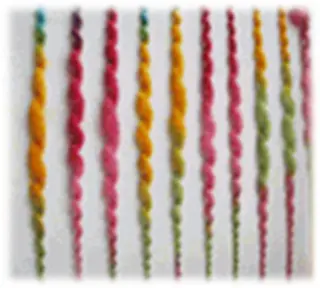What is Novelty Yarn? Types of Novelty Yarn in Textile Spinning
The construction of Novelty yarn is advanced and varied in many ways. Novelty yarn square measures sometimes ply yarns of various styles of fibers or of various colors and square measure irregularly instead of swish single strand or yarn of varied colors, sizes of fibers could also be twisted along to create advanced yarn. Another selection is led to during this quiet yarn by varying the stress or speed when intervals of sure length. therefore permitting one half to loop or pervert the opposite. In this article, we discuss What is Novelty Yarn and Types of Novelty Yarn in Textile Spinning.
Novelty yarns are also created from straightforward yarn by varying the number of twists. The advanced sort of novelty yarn is employed with 2 objects visible one is to mix completely different fibers eg. Cotton and fabric could also be mixed with or lined by wool or silk. This lowers the price of production. the opposite objective is to provide a novelty yarn. For the development of novelty yarns, a minimum of one or 2 single yarns square measure use.
One forms the inspiration yarn called a base or the core and therefore the different, The impact of yarn that is wound or whorled around the initial one. a 3rd yarn known as binder yarn is commonly wont to fasten or tie the impact yarn to the inspiration yarn. These kinds of yarn square measure largely used for material, upholstery materials.
Types of Novelty Yarn in textile spinning
Novelty yarn and and types of novelty yarn are one kind of fancy yarn. We produce it in textile yarn manufacturing. The use of it is for decorative purposes. Now we use novelty yarns in the art of fashion and designing textiles. Here are the types of novelty yarn in textile spinning discussed below.
Slub yarn
This is a yarn with thick and thin placing by varying the amount of twist in the yarn at regular intervals. Basically we find it in drapery and upholstery fabrics.

Flock Yarn
The other name of these yarns is flake yarns. This is one type of novelty yarn. These are usually single yarns in which small amounts of fibers either different colors or luster or both are placed by inserted into the yarn and held in place by a twist of base yarn eg: tweed fabric. This gives a spotted and short streaky appearance.

Thick and Thin Yarns:
These are similar to slub yarns but we make it from filament like slub prepared from staples. The pressure forcing the spinning solution varies the filament to thick in some places and thin in some.
Boucle Yarn:
The characterization of these yarn processes by projecting from the body of the yarn at fairly regular intervals. There are 3 ply yarns. The effect yarns forms irregular way surface and the binder ties it to the base. It has twisted core yarn.

Loop and curl yarn, Gimp yarn:
Gimp is the same as a boucle but the effect yarn is a regular semi-circular appearance, while in a loop.
Snarl yarn or spike yarn:
This is the same way as loop yarn using a highly twisted effect yarn, which forms snarls rather than loops.
Knop (button) yarn/knot/Nub/Spot yarn:
This features prominent bunches of one or more of the component yarn at regular or irregular intervals. This is made on a special machine that permits the base yarn to be held almost stationary while the effect yarn is wrapped around it several times to build upon an enlarged segment with brightly colored fibers added at the enlarged spot.
- Seed or Splash: They resemble knops or knot yarns but the knot segments are tiny in seed yarn and elongated in splash yarn.
- Cloud: A two coloured yarn, in which both yarns take in turn to obscure or cloud the other, giving the appearance of an intermittent color change.
- Spiral or Corkscrew : It is made by twisting together two ply yarns that differ in size, type or twist. These two parts may be delivered to the twister at different rates of speed.
Chenille Yarn:
These create special effects chenille means caterpillar in French. The yarn has a cut pile effect wh bound to the core on the loom warps are arranged in groups (2-6) which are interlaced in a cross weaving manner. Weft need to insert in a normal manner. Need to cut these into wrap way threads.
Metallic Yarn:
These are primarily decorative. The plastic coasting on it resists tarnishing but care must need to take while pressing as pure metals are soft, their thin films use over a core yarn that has replaced gold and slivers now. There are two methods of pressing.


